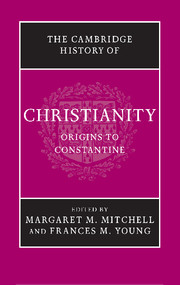Book contents
- Frontmatter
- Prelude: Jesus Christ, foundation of Christianity
- Part I The Political, Social and Religious Setting
- Part II The Jesus Movements
- Part III Community Traditions and Self-Definition
- Part IV Regional Varieties of Christianity in the First Three Centuries
- Part V The Shaping of Christian Theology
- Part VI ‘Aliens’ become Citizens: towards Imperial Patronage
- 28 Persecutions: genesis and legacy
- 29 Church and state up to c.300 ce
- 30 Constantine and the ‘peace of the church’
- 31 The first Council of Nicaea
- 32 Towards a Christian material culture
- Conclusion: retrospect and prospect
- Bibliographies
- Index
- Map 1. The Roman Empire in the time of Marcus Aurelius
- References
30 - Constantine and the ‘peace of the church’
from Part VI - ‘Aliens’ become Citizens: towards Imperial Patronage
Published online by Cambridge University Press: 28 March 2008
- Frontmatter
- Prelude: Jesus Christ, foundation of Christianity
- Part I The Political, Social and Religious Setting
- Part II The Jesus Movements
- Part III Community Traditions and Self-Definition
- Part IV Regional Varieties of Christianity in the First Three Centuries
- Part V The Shaping of Christian Theology
- Part VI ‘Aliens’ become Citizens: towards Imperial Patronage
- 28 Persecutions: genesis and legacy
- 29 Church and state up to c.300 ce
- 30 Constantine and the ‘peace of the church’
- 31 The first Council of Nicaea
- 32 Towards a Christian material culture
- Conclusion: retrospect and prospect
- Bibliographies
- Index
- Map 1. The Roman Empire in the time of Marcus Aurelius
- References
Summary
The reign of Constantine (306–37 ce) was momentous for Christianity. Before it, and indeed during Constantine’s first years, Christians continued to suffer persecution; after it, all but one emperor followed Constantine’s example in supporting Christianity. Christianity did not become the official religion of the empire under Constantine, as is often mistakenly claimed, but imperial hostility had turned into enthusiastic support, backed with money and patronage. However, some of Constantine’s actions opened up splits between the Christians themselves. The term the ‘peace of the church’, used by Christians to denote the ending of persecution, is something of a misnomer in light of the violent quarrels which followed during the rest of the fourth century and after. Nevertheless, Constantine’s patronage of the church set it on an altogether different path and made it in a real sense a public institution with a legal presence and official recognition.
Sources
The successive literary works by Eusebius, bishop of Caesarea (d. c.349 ce), breathe the amazement, and at first almost the disbelief, of a Christian who had visited mutilated clergy in Egypt during the Diocletianic persecution, and then found all his expectations suddenly reversed. Eusebius’s Historia ecclesiastica (‘History of the church’), perhaps begun even before the outbreak of persecution in 303 ce and written over a long period of years, had to be revised more than once as events succeeded each other in startling sequence.
- Type
- Chapter
- Information
- The Cambridge History of Christianity , pp. 538 - 551Publisher: Cambridge University PressPrint publication year: 2006
References
- 5
- Cited by

